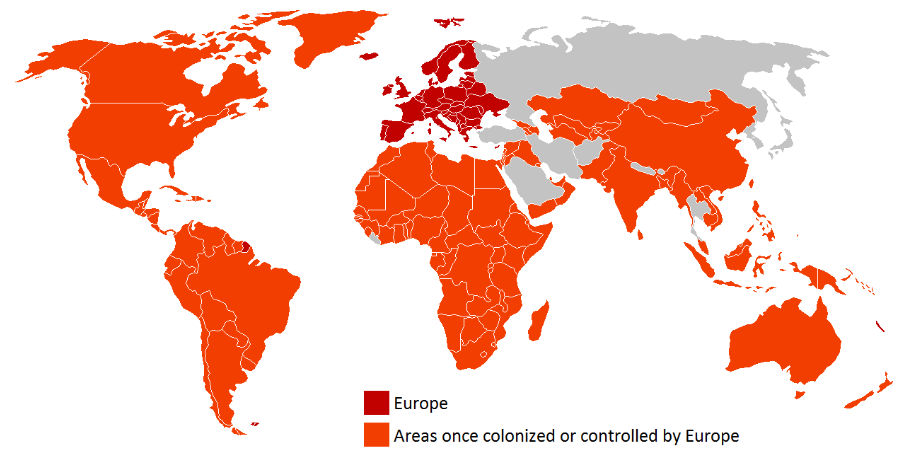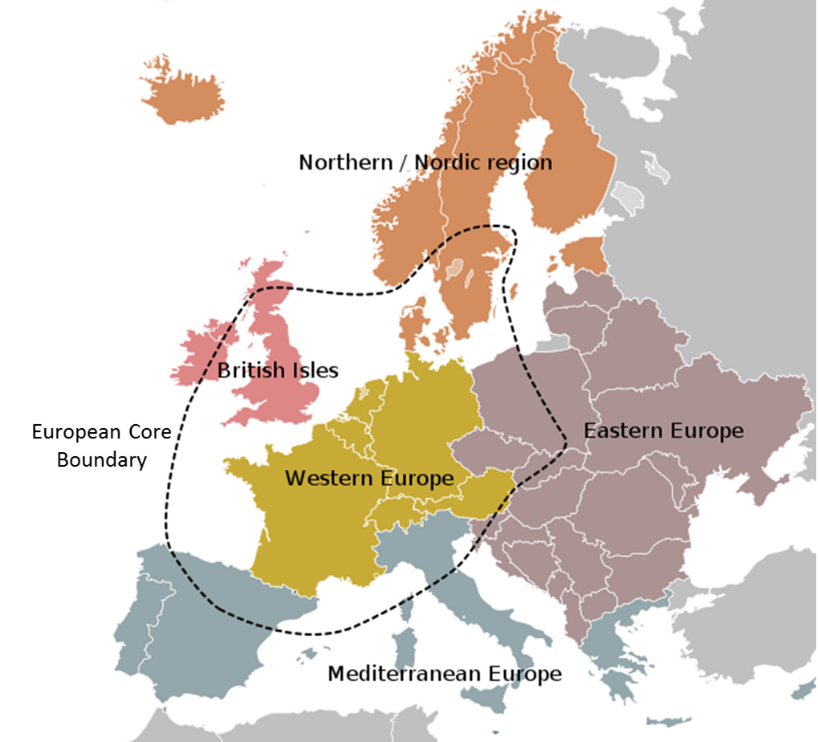Compiled by Karin Lundberg.
Conditions of Use:

Unless otherwise noted, this work is licensed under a Creative Commons Attribution-NonCommercial 4.0 International License..
Kate Lyons is the librarian assisting with this OER.
Full content by Caitlin Finlayson, Assistant Professor at University of Mary Washington, and available here: on the LibreTexts website
Industrial Revolution
The differences in levels of development across Europe today have largely been shaped by the Industrial Revolution. The Industrial Revolutionrefers to the changes in manufacturing that occurred in the late 18th and early 19th centuries. These changes had profound effects on society, economics, and agriculture, not just in Europe, but globally.
Prior to the Industrial Revolution, most goods in Europe were produced in the home. These so-called “cottage” industries consisted of individual workers making unique goods in their homes, usually on a part-time basis. These products, such as clothing, candles, or small housewares, could be sold by a farming family to supplement their income.
The Industrial Revolution began in the United Kingdom, and while it’s difficult to pinpoint the exact point at which the revolution began, a key invention was James Watt’s steam engine, which entered production in 1775. This steam-driven engine was adopted by industries to allow for factory production. Machines could now be used instead of human or animal labor. Interestingly, a side effect of the steam engine was that it enabled better iron production, since iron required an even and steady stream of heat. This improved iron was then used to build more efficient steam engines, which in turn produced increasingly better iron. These improvements and new technologies gradually spread across Europe, eventually diffusing to the United States and Japan.
During this time, there were also significant changes in agricultural production. The Agrarian Revolution began in the mid-1750s and was based upon a number of agricultural innovations. This was the Age of Enlightenment, and the scientific reasoning championed during this era was applied to the growing of crops. Farmers began using mechanized equipment, rather than relying solely on human or animal labor. Fertilizers improved soil conditions, and crop rotation and complementary planting further increased crop yields. During this time period, there was a shift to commercial agriculture, where excess crops are sold for a profit, rather than subsistence agriculture, where farmers primarily grow food for their own family’s consumption.
Around the same time improvements in rail transportation changed both the way goods were distributed across Europe and the movement of people across the region. The use of steam engines and improved iron also transformed the shipping industry, with steamships beginning to set sail across the Atlantic Ocean.
The Agrarian Revolution coupled with the Industrial Revolution profoundly changed European geography. With the improvements of the Agrarian Revolution, farmers could produce more with less work. This provided an agricultural surplus, enabling a sustained population increase. Port cities and capital cities became centers of trade and expanded. Critically, the Agrarian Revolution freed workers from having to farm, since fewer farmers were needed to produce the same amount of crops, enabling people to find work in the factories. These factories were primarily located in cities, and thus it was the combination of these two revolutions that dramatically increased urbanization in Europe. At the start of the 19th century, around 17 percent of England’s population lived in cities; by the end of the 19th century, that figure had risen to 54 percent.
Overall, the Industrial Revolution considerably improved European power by boosting their economies, improving their military technology, and increasing their transportation efficiency. Even before the Industrial Revolution, Europe exerted a considerable amount of control over the rest of the world. European colonialism began in the 1400s, led by Portugal and Spain. In the 1500s, England, France, and the Dutch began their own colonial campaigns. By the start of WorldWar I, the British Empire, boosted by the improvements of the Industrial Revolution, had the largest empire in history, covering 20 percent of the world’s population at the time (Figure 2.3.12.3.1).

Coinciding with the Industrial and Agrarian Revolutions were a number of political revolutions in Europe. The most influential political change came as the result of the French Revolution, which occurred between 1789 and 1799 CE. This revolution ended France’s monarchy, establishing a republic, and provided the foundation for numerous political revolutions that followed. It also weakened the power of the Roman Catholic Church in France, inspiring the modern-day separation between church and state that is typical of many Western countries, including the United States.
Today, the map of Europe reflects the changes brought about by the Industrial and Agrarian Revolutions as well as the political changes that took place throughout the time period. Europe’s core area, where economic output is highest, is largely centered around the manufacturing areas that arose during the Industrial Revolution (Figure 2.3.22.3.2). These manufacturing areas in turn were originally located near the raw materials, such as coal, that could sustain industrial growth.

The shift in labor that occurred during the Industrial Revolution, as people left rural farms to find work in factories, led to the specialization of labor that is found in Europe today. Areas within Europe tended to specialize in the production of particular goods. Northern Italy for example, has maintained a specialty in the production of textiles. Germany continues to specialize in automotive manufacturing. The Benz Patent-Motorwagen, the world’s first gasoline powered automobile, was first built in Germany in 1886 and would later develop into the Mercedes-Benz corporation. As regions focused on the manufacture of particular goods, they benefited from economies of scale, the savings in cost per unit that results from increasing production. If you wanted to build a chair, for example, you’d have to buy the wood, glue, and screws as well as the tools needed to construct it, such as a drill, sander, and saw. That single chair would be quite costly to produce. If you wanted to make ten chairs, however, those same tools could be used for every chair, driving the cost of each chair down. Many areas in Europe have shifted from more traditional to high-tech manufacturing and industrial output in the region remains high.
Big Changes
-- Article by Christopher Brooks of Partland Community College. The full text is available on the LibreTexts website.
One of the most vexing questions for historians is how to identify the causes of nineteenth-century European dominance: how does one explain the simple fact that Europe controlled a staggering amount of territory all around the globe by 1900? The old Eurocentric viewpoint was that there was something unique about European culture that gave it a competitive edge in the world. The even older version, popular among Europeans themselves in the late nineteenth century, was openly racist and chauvinistic: it claimed that European civilization was the bearer of critical thought itself, of technological know-how, of piercing insight and practical sense. All other civilizations were, in this model, regarded as either hopelessly backward or stuck in a previous stage of cultural or even biological evolution.
That explanation was, obviously, not just self-serving but inaccurate. Nineteenth-century Europeans rarely lived up to their own inflated view of themselves, and more to the point, their dominance was extremely short-lived. Europe had a technological lead on most other world regions for less than a century. The Industrial Revolution began in England in about 1750, took almost a century to spread to other parts of western Europe (a process that began in earnest around 1830), and reached maturity by the 1850s and 1860s. In turn, European industrial power was overwhelming in comparison to the rest of the world, except the United States starting in the last decades of the nineteenth century, from about 1860 - 1914. After that, Europe’s competitive edge began a steady decline, one that coincided with the collapse of its global empires after World War II.
A more satisfying explanation for the explosion of European power than one that claims that Europeans had some kind of inherent cultural advantage has to do with energy. For about a century, Europe and, eventually, the United States, had almost exclusive access to what amounted to unlimited energy in the form of fossil fuels. The iconic battles toward the end of the century between rifle-wielding European soldiers and the people they conquered in Africa and parts of Asia were not just about the rifles; they were about the factories that made those rifles, the calories that fed the soldiers, the steamships that transported them there, the telegraph lines that conveyed orders for thousands of miles away, the medicines that kept them healthy, and so on, all of which represented an epochal shift from the economic and technological reality of the people trying to resist European imperialism. All of those inventions could be produced in gigantic quantities thanks to the use of coal and, later, oil power.
While many historians have taken issue with the term “revolution” in describing what was much more of a slow evolution at the time, there is no question that the changes industrial technology brought about really were revolutionary. Few things have mattered as much as the Industrial Revolution, because it fundamentally transformed almost everything about how human beings live, perhaps most strikingly including humankind’s relationship with nature. Whole landscapes can be transformed, cities constructed, species exterminated, and the entire natural ecosystem fundamentally changed in a relatively short amount of time.
Likewise, “the” Industrial Revolution was really a linking together of distinct “revolutions” – technology started it, but the effects of those technological changes were economic and social. All of society was eventually transformed, leading to the phrase “industrial society,” one in which everything is in large part based on the availability of a huge amount of cheap energy and an equally huge number of mass-produced commodities (including people, insofar as workers can be replaced). To sum up, the Industrial Revolution was as momentous in human history as was the agricultural revolution that began civilization back in about 10,000 BCE. Even if it was a revolution that took over a century to come to fruition, from a long-term world-historical perspective, it still qualifies as revolutionary.
Library Info and Research Help | reflibrarian@hostos.cuny.edu (718) 518-4215
Loans or Fines | circ@hostos.cuny.edu (718) 518-4222
475 Grand Concourse (A Building), Room 308, Bronx, NY 10451
